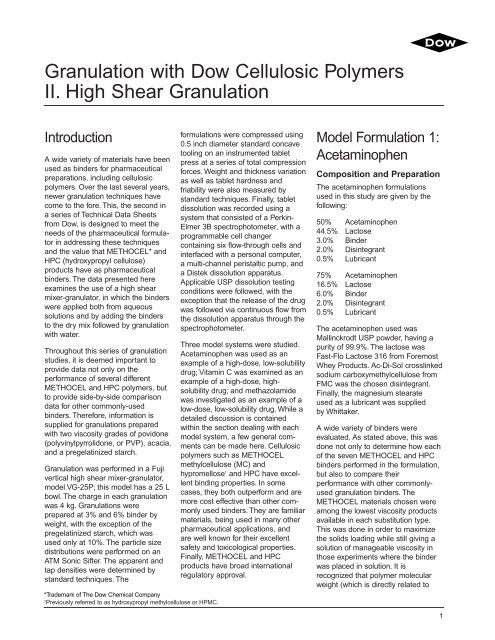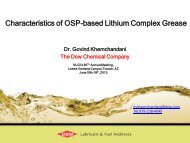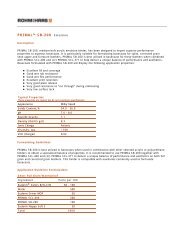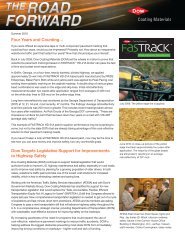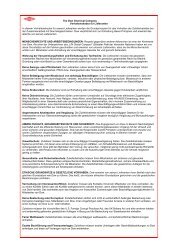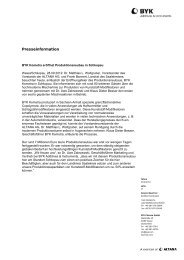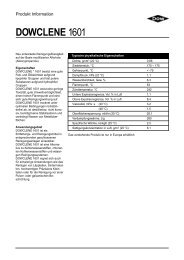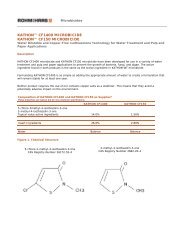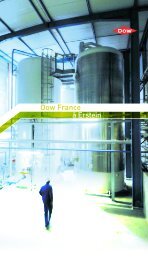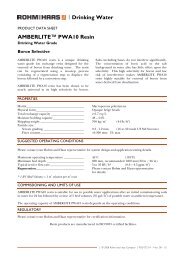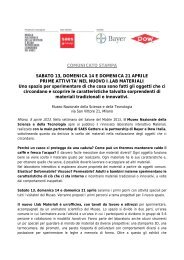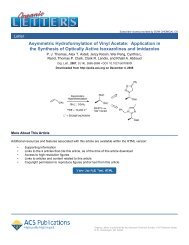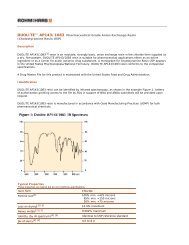Granulation with Dow Cellulosic Polymers II. High Shear Granulation
Granulation with Dow Cellulosic Polymers II. High Shear Granulation
Granulation with Dow Cellulosic Polymers II. High Shear Granulation
Create successful ePaper yourself
Turn your PDF publications into a flip-book with our unique Google optimized e-Paper software.
<strong>Granulation</strong> <strong>with</strong> <strong>Dow</strong> <strong>Cellulosic</strong> <strong>Polymers</strong><br />
<strong>II</strong>. <strong>High</strong> <strong>Shear</strong> <strong>Granulation</strong><br />
Introduction<br />
A wide variety of materials have been<br />
used as binders for pharmaceutical<br />
preparations, including cellulosic<br />
polymers. Over the last several years,<br />
newer granulation techniques have<br />
come to the fore. This, the second in<br />
a series of Technical Data Sheets<br />
from <strong>Dow</strong>, is designed to meet the<br />
needs of the pharmaceutical formulator<br />
in addressing these techniques<br />
and the value that METHOCEL* and<br />
HPC (hydroxypropyl cellulose)<br />
products have as pharmaceutical<br />
binders. The data presented here<br />
examines the use of a high shear<br />
mixer-granulator, in which the binders<br />
were applied both from aqueous<br />
solutions and by adding the binders<br />
to the dry mix followed by granulation<br />
<strong>with</strong> water.<br />
Throughout this series of granulation<br />
studies, it is deemed important to<br />
provide data not only on the<br />
performance of several different<br />
METHOCEL and HPC polymers, but<br />
to provide side-by-side comparison<br />
data for other commonly-used<br />
binders. Therefore, information is<br />
supplied for granulations prepared<br />
<strong>with</strong> two viscosity grades of povidone<br />
(polyvinylpyrrolidone, or PVP), acacia,<br />
and a pregelatinized starch.<br />
<strong>Granulation</strong> was performed in a Fuji<br />
vertical high shear mixer-granulator,<br />
model VG-25P; this model has a 25 L<br />
bowl. The charge in each granulation<br />
was 4 kg. <strong>Granulation</strong>s were<br />
prepared at 3% and 6% binder by<br />
weight, <strong>with</strong> the exception of the<br />
pregelatinized starch, which was<br />
used only at 10%. The particle size<br />
distributions were performed on an<br />
ATM Sonic Sifter. The apparent and<br />
tap densities were determined by<br />
standard techniques. The<br />
*Trademark of The <strong>Dow</strong> Chemical Company<br />
† Previously referred to as hydroxypropyl methylcellulose or HPMC.<br />
formulations were compressed using<br />
0.5 inch diameter standard concave<br />
tooling on an instrumented tablet<br />
press at a series of total compression<br />
forces. Weight and thickness variation<br />
as well as tablet hardness and<br />
friability were also measured by<br />
standard techniques. Finally, tablet<br />
dissolution was recorded using a<br />
system that consisted of a Perkin-<br />
Elmer 3B spectrophotometer, <strong>with</strong> a<br />
programmable cell changer<br />
containing six flow-through cells and<br />
interfaced <strong>with</strong> a personal computer,<br />
a multi-channel peristaltic pump, and<br />
a Distek dissolution apparatus.<br />
Applicable USP dissolution testing<br />
conditions were followed, <strong>with</strong> the<br />
exception that the release of the drug<br />
was followed via continuous flow from<br />
the dissolution apparatus through the<br />
spectrophotometer.<br />
Three model systems were studied.<br />
Acetaminophen was used as an<br />
example of a high-dose, low-solubility<br />
drug; Vitamin C was examined as an<br />
example of a high-dose, highsolubility<br />
drug; and methazolamide<br />
was investigated as an example of a<br />
low-dose, low-solubility drug. While a<br />
detailed discussion is contained<br />
<strong>with</strong>in the section dealing <strong>with</strong> each<br />
model system, a few general comments<br />
can be made here. <strong>Cellulosic</strong><br />
polymers such as METHOCEL<br />
methylcellulose (MC) and<br />
hypromellose † and HPC have excellent<br />
binding properties. In some<br />
cases, they both outperform and are<br />
more cost effective than other commonly<br />
used binders. They are familiar<br />
materials, being used in many other<br />
pharmaceutical applications, and<br />
are well known for their excellent<br />
safety and toxicological properties.<br />
Finally, METHOCEL and HPC<br />
products have broad international<br />
regulatory approval.<br />
Model Formulation 1:<br />
Acetaminophen<br />
Composition and Preparation<br />
The acetaminophen formulations<br />
used in this study are given by the<br />
following:<br />
50% Acetaminophen<br />
44.5% Lactose<br />
3.0% Binder<br />
2.0% Disintegrant<br />
0.5% Lubricant<br />
75% Acetaminophen<br />
16.5% Lactose<br />
6.0% Binder<br />
2.0% Disintegrant<br />
0.5% Lubricant<br />
The acetaminophen used was<br />
Mallinckrodt USP powder, having a<br />
purity of 99.9%. The lactose was<br />
Fast-Flo Lactose 316 from Foremost<br />
Whey Products. Ac-Di-Sol crosslinked<br />
sodium carboxymethylcellulose from<br />
FMC was the chosen disintegrant.<br />
Finally, the magnesium stearate<br />
used as a lubricant was supplied<br />
by Whittaker.<br />
A wide variety of binders were<br />
evaluated. As stated above, this was<br />
done not only to determine how each<br />
of the seven METHOCEL and HPC<br />
binders performed in the formulation,<br />
but also to compare their<br />
performance <strong>with</strong> other commonlyused<br />
granulation binders. The<br />
METHOCEL materials chosen were<br />
among the lowest viscosity products<br />
available in each substitution type.<br />
This was done in order to maximize<br />
the solids loading while still giving a<br />
solution of manageable viscosity in<br />
those experiments where the binder<br />
was placed in solution. It is<br />
recognized that polymer molecular<br />
weight (which is directly related to<br />
1
solution viscosity) can be an<br />
important variable in the effectiveness<br />
of a binder. The effect of molecular<br />
weight will be addressed in<br />
subsequent studies.<br />
The METHOCEL polymers used<br />
included: METHOCEL A15P LV<br />
(15 cps methylcellulose USP);<br />
METHOCEL E5P LV and E15P LV<br />
(5 and 15 cps hypromellose, USP<br />
substitution type 2910); METHOCEL<br />
K3P LV (3 cps hypromellose, USP<br />
substitution type 2208); and<br />
METHOCEL F4P LV (hypromellose<br />
USP substitution type 2906). The<br />
METHOCEL polymer is in many ways<br />
similar to the material identified as<br />
METHOCEL F4P LV in Part I, Fluid<br />
Bed <strong>Granulation</strong>. By the USP<br />
monographs, MC and hypromellose<br />
viscosities are reported as those<br />
obtained from 2% aqueous solutions,<br />
measured in a Ubbelohde (capillary)<br />
viscometer at 20°C.<br />
The HPC polymers utilized were the<br />
HPC-EF and HPC-LF grades. HPC-<br />
EF has a viscosity of 250-750 cps,<br />
measured as the viscosity of a 10%<br />
aqueous solution at 20°C <strong>with</strong> a<br />
Brookfield viscometer, using the #2<br />
spindle at 30 rpm. The viscosity of<br />
HPC-LF is 75-150 cps, measured as<br />
a 5% aqueous solution at 20°C, again<br />
using the Brookfield viscometer, #2<br />
spindle, and 30 rpm.<br />
2 <strong>High</strong> <strong>Shear</strong> <strong>Granulation</strong>: Acetaminophen Model<br />
The povidones used in this study<br />
were USP grades of the K29-32 and<br />
K90 types.<br />
Acacia (gum arabic, spray dried<br />
SDGA/1) was obtained from AEP<br />
Colloids, Inc. The spray dried form is<br />
white to very pale yellow and is in<br />
compacted fragments or whole<br />
spheres. One gram dissolves in 2 ml.<br />
of water, forming a solution which<br />
flows readily and is acidic to litmus.<br />
A pregelatinized starch having a coldwater<br />
soluble fraction of 10 to 20%<br />
was included in the study. This type of<br />
starch is a combination of<br />
approximately 5% amylose, 15%<br />
amylopectin, and 80% unmodified<br />
corn starch, <strong>with</strong> at least 90% of the<br />
particle weight less than U.S. sieve<br />
size 100.<br />
In all cases except the pregelatinized<br />
starch and the acacia, the binder was<br />
added both as an aqueous solution<br />
and in the dry state (in which the<br />
granulating liquid was simply water).<br />
The powders were charged into the<br />
granulator and premixed for 60<br />
seconds at high chopper speed and<br />
200 rpm main impeller setting to<br />
delump and homogeneously mix the<br />
contents. The binder solution or<br />
simply water was added to the<br />
granulation while the Fugi was<br />
operated at high chopper speed and<br />
200 main impeller speed until a<br />
proper wet mass was achieved. The<br />
resultant wet mass was passed<br />
through a CoMil (Quadro, Inc.)<br />
equipped <strong>with</strong> a square hole screen<br />
(2A-3750037/63), impeller (2A-1606-<br />
086L) operating at a speed of 2665<br />
rpm. The milled material was placed<br />
on trays and oven dried at 110°F to a<br />
final moisture endpoint of 1-2%. The<br />
moisture analysis was performed on<br />
a Mettler Infrared Drying Unit LP16-M<br />
(Mettler, Inc.). Upon drying, the<br />
granulation was dry sized via the<br />
same CoMil operating at the same<br />
speed setting and equipped <strong>with</strong> a<br />
round hole grater-type screen<br />
(2A 079G031/23120) and impeller<br />
(2A-1601-173). After dry sizing, the<br />
granulation was placed in a V-blender,<br />
where the lactose and disintegrant<br />
were added and mixed for 10<br />
minutes. Finally, the lubricant was<br />
added, and following an additional 2<br />
minutes of mixing, the final mixture<br />
was compressed at 1000, 2000, and<br />
3000 lbs. total compression force on<br />
an instrumented rotary tablet press.
Properties of the <strong>Granulation</strong><br />
The complete granulations (including<br />
the disintegrant and lubricant) were<br />
characterized by a number of simple<br />
techniques. The apparent and tap<br />
densities of the granulations were<br />
determined using simple<br />
weight/volume measurements and a<br />
Vanderkamp tap density tester (500<br />
taps). From the apparent and tap<br />
densities, one can calculate the socalled<br />
compressibility index (I) given<br />
by the equation<br />
va<br />
I = [ 1 – x 100,<br />
vt<br />
]<br />
where va is the apparent density and<br />
vt is the tapped density. I can be used<br />
as a rough indication of the flow<br />
Table 1<br />
BINDERS IN SOLUTION<br />
Apparent Tap<br />
Density Density I(%)<br />
3% A15P LV 0.62 0.72 15<br />
6% A15P LV 0.59 0.70 16<br />
3% E5P LV 0.62 0.77 20<br />
6% E5P LV 0.61 0.75 19<br />
3% E15P LV 0.60 0.76 20<br />
6% E15P LV 0.62 0.71 12<br />
3% F4P LV 0.60 0.78 23<br />
6% F4P LV 0.58 0.78 24<br />
3% K3P LV 0.59 0.75 21<br />
6% K3P LV 0.57 0.74 24<br />
3% HPC-EF 0.59 0.73 19<br />
6% HPC-EF 0.62 0.76 18<br />
3% HPC-LF 0.63 0.81 22<br />
6% HPC-LF 0.62 0.76 18<br />
3% PVP (K29-32) 0.58 0.75 22<br />
6% PVP (K29-32) 0.57 0.74 22<br />
3% PVP (K90) 0.53 0.71 25<br />
6% PVP(K90) 0.51 0.70 26<br />
6% Acacia 0.57 0.74 23<br />
10% Pregel. starch 0.57 0.68 16<br />
properties of a material, where I<br />
values of less than 15% are indicative<br />
of good flow characteristics, while<br />
values above 25% are indicative of<br />
poor flow properties. The data for the<br />
acetaminophen granulations are<br />
presented in Table 1, in the case<br />
where the binder was applied from a<br />
solution, and in Table 2, where the<br />
binder was added in a dry state to<br />
the mixer-granulator followed by<br />
granulation <strong>with</strong> water. The densities<br />
are in units of g/cm 3 .<br />
In this acetaminophen model<br />
system, because of composition<br />
differences (3% binder/50% drug and<br />
6% binder/75% drug), comparisons<br />
are made only between similar<br />
binder levels.<br />
Table 2<br />
BINDERS DRY<br />
For the "solution" method, there were<br />
only small differences in the apparent<br />
densities between the binders except<br />
for the PVP (K90) binder, which<br />
exhibited a little lower density at both<br />
the 3% and 6% levels. The values for<br />
I varied from 15-25% at the 3% level,<br />
and from 12-26% at the 6% level, the<br />
highest values in both cases<br />
occurring <strong>with</strong> the PVP (K90). With<br />
the "dry" binder addition method, the<br />
densities at both binder<br />
concentrations tended to be very<br />
similar to those obtained by the<br />
solution method. The lowest densities<br />
and highest I values resulted from the<br />
use of PVP (K90) as a binder in this<br />
case as well.<br />
Apparent Tap<br />
Density Density I(%)<br />
3% A15P LV 0.64 0.77 17<br />
6% A15P LV 0.57 0.69 16<br />
3% E5P LV 0.56 0.74 24<br />
6% E5P LV 0.60 0.76 21<br />
3% E15P LV 0.65 0.76 14<br />
6% E15P LV 0.59 0.73 19<br />
3% F4P LV 0.61 0.78 22<br />
6% F4P LV 0.57 0.75 24<br />
6% K3P LV 0.59 0.75 22<br />
3% HPC-EF 0.61 0.74 18<br />
6% HPC-EF 0.56 0.73 24<br />
3% HPC-LF 0.58 0.70 17<br />
6% HPC-LF 0.57 0.72 20<br />
3% PVP (K29-32) 0.58 0.75 23<br />
6% PVP (K29-32) 0.54 0.70 22<br />
3% PVP (K90) 0.53 0.71 25<br />
6% PVP(K90) 0.51 0.70 27<br />
<strong>High</strong> <strong>Shear</strong> <strong>Granulation</strong>: Acetaminophen Model<br />
3
The particle size distribution (PSD) of<br />
the granulations were also<br />
determined. The amount of material<br />
retained on U.S. standard sieves of<br />
20, 40, 60, 80, 100, and 140 mesh<br />
was measured, using an ATM Sonic<br />
Sifter. A few typical particles size<br />
distributions are given by Figures 1-9<br />
and present data for both binder<br />
addition methods.<br />
Figure 1 compares granules <strong>with</strong> 3%<br />
and 6% METHOCEL A15P LV. While<br />
the differences are minimal, 6%<br />
binder "dry" had less material<br />
retained on the 40 mesh screen and<br />
slightly more on the remaining sieves.<br />
Bar graphs for METHOCEL E5P LV<br />
(Figure 2) and E15P LV (Figure 3)<br />
demonstrate the impact of molecular<br />
weight on PSD. The METHOCEL<br />
E15P LV (15 cps) generated a larger<br />
overall particle size than did the<br />
METHOCEL E5P LV (5 cps) binder.<br />
The particle size distributions for<br />
METHOCEL K3P LV and F4P LV<br />
were characterized by having slightly<br />
less material on 40 mesh and slightly<br />
more material on 60 mesh than the<br />
distribution given in Figure 3.<br />
4 <strong>High</strong> <strong>Shear</strong> <strong>Granulation</strong>: Acetaminophen Model
<strong>High</strong> <strong>Shear</strong> <strong>Granulation</strong>: Acetaminophen Model<br />
5
HPC-EF and -LF are depicted in<br />
Figures 4 and 5, respectively. The<br />
HPC-EF and HPC-LF showed fairly<br />
similar particle size distributions. PVP<br />
(K29-32) (Figure 6) and PVP (K90)<br />
(Figure 7) also exhibited somewhat<br />
similar PSD profiles. The K29-32<br />
grade shows a slightly greater<br />
amount of material retained on the 40<br />
mesh. Figure 8 is a comparison of the<br />
cellulosic polymer, METHOCEL<br />
A15P LV, and pregelatinized starch.<br />
The METHOCEL product produced<br />
substantially more 20 and 40 mesh<br />
granules than the pregelatinized<br />
starch. Finally, Figure 9 shows the<br />
PSD of acacia and METHOCEL<br />
A15P LV at 6%. The acacia produced<br />
a PSD that was comparable to the<br />
cellulosic binders. This distribution<br />
was very different from the extremely<br />
fine granulation obtained when acacia<br />
was used in fluid bed granulation.<br />
6 <strong>High</strong> <strong>Shear</strong> <strong>Granulation</strong>: Acetaminophen Model
Tablet Physical Properties<br />
The hardness and friability of the 0.5<br />
inch tablets compressed at 2000 lbs.<br />
total compression force are given in<br />
Tables 3 and 4. For both<br />
measurements, 20 tablets were used;<br />
the reported friabilities are those after<br />
4 minutes in a Roche-type friabilator.<br />
Examining the data of Table 3, it is<br />
clear that good, hard tablets were<br />
produced, <strong>with</strong> the exception of those<br />
compressed from the acacia<br />
granulations; acacia has again been<br />
shown to be a relatively poor binder<br />
for this formulation. In most cases, the<br />
Table 3<br />
BINDERS IN SOLUTION<br />
Hardness Friability<br />
(SCU) ± sd (%)<br />
3% A15P LV 17.1 ± 1.7 0.30<br />
6% A15P LV 16.2 ± 1.6 0.30<br />
3% E5P LV 19.9 ± 2.0 0.27<br />
6% E5P LV 16.8 ± 2.2 0.39<br />
3% E15P LV 13.3 ± 1.3 0.30<br />
6% E15P LV 17.1 ± 1.7 0.50<br />
3% F4P LV 19.0 ± 2.3 0.28<br />
6% F4P LV 15.9 ± 1.6 0.38<br />
3% K3P LV 20.6 ± 2.2 0.31<br />
6% K3P LV 19.3 ± 2.6 0.40<br />
3% HPC-EF 27.2 ± 3.7 0.24<br />
6% HPC-EF 15.8 ± 1.3 0.38<br />
3% HPC-LF 26.0 ± 3.1 0.28<br />
6% HPC-LF 19.1 ± 1.5 0.34<br />
3% PVP (K29-32) 20.9 ± 2.3 0.37<br />
6% PVP (K29-32) 20.5 ± 2.8 0.38<br />
3% PVP (K90) 23.5 ± 2.5 0.35<br />
6% PVP (K90) 24.3 ± 2.9 0.33<br />
6% Acacia 8.5 ± 1.6 capped<br />
10% Pregel. Starch 13.9 ± 2.6 capped<br />
tablets <strong>with</strong> 3% binder were harder<br />
than those <strong>with</strong> 6% binder; this is<br />
most likely due to the differences in<br />
the formulations and the inherent<br />
incompressiblity of acetaminophen.<br />
The exceptions to this observation<br />
were the METHOCEL E15P LV and<br />
PVP (K90) binders. At the 3% level,<br />
the hardest tablets were made from<br />
HPC-EF and -LF granulations, from<br />
the povidone granulations, and from<br />
the METHOCEL K3P LV granulation.<br />
Similarly, at the 6% level, the hardest<br />
tablets were those resulting from<br />
granulations prepared <strong>with</strong> the PVPs,<br />
METHOCEL K3P LV, and HPC-LF.<br />
Table 4<br />
BINDERS DRY<br />
Overall, very good friabilities were<br />
achieved by the solution addition<br />
method. The binders giving the lowest<br />
friability tablets were 3% HPC-EF, 3%<br />
METHOCEL E5P LV, 3% HPC-LF,<br />
and 3% METHOCEL F4P LV. (Note<br />
that these all were formulations<br />
containing 50% acetaminophen.) The<br />
tablets <strong>with</strong> the highest friability were<br />
the 6% acacia and 10%<br />
pregelatinized starch, which both<br />
capped. Tablets containing 6%<br />
METHOCEL E15P LV, which had a<br />
friability of only 0.50%, were the most<br />
friable of those that did not cap.<br />
Hardness Friability<br />
(SCU) ± sd (%)<br />
3% A15P LV 21.5 ± 2.0 0.21<br />
6% A15P LV 14.3 ± 1.5 0.42<br />
3% E5P LV 20.6 ± 2.9 0.27<br />
6% E5P LV 17.1 ± 2.0 0.38<br />
3% E15P LV 14.3 ± 1.6 0.36<br />
6% E15P LV 14.6 ± 1.8 0.45<br />
3% F4P LV 24.8 ± 2.0 0.24<br />
6% F4P LV 16.6 ± 2.1 0.32<br />
6% K3P LV 19.9 ± 2.3 0.39<br />
3% HPC-EF 20.6 ± 1.6 0.24<br />
6% HPC-EF 22.6 ± 1.6 0.24<br />
3% HPC-LF 23.5 ± 1.3 0.25<br />
6% HPC-LF 23.3 ± 1.1 0.27<br />
3% PVP (K29-32) 22.1 ± 2.6 0.35<br />
6% PVP (K29-32) 24.0 ± 2.2 0.35<br />
3% PVP (K90) 28.3 ± 2.3 0.24<br />
6% PVP (K90) 23.4 ± 3.1 0.34<br />
<strong>High</strong> <strong>Shear</strong> <strong>Granulation</strong>: Acetaminophen Model<br />
7
The dry binder addition method (see<br />
Table 4) also produced tablets <strong>with</strong><br />
excellent hardness overall. The<br />
results were somewhat mixed<br />
concerning which binder level gave<br />
the harder tablets (in 5 of the 9<br />
cases, the tablets at 3% binder were<br />
harder). At the 3% binder<br />
concentration, the hardest tablets<br />
were made <strong>with</strong> the PVP (K90),<br />
METHOCEL F4P LV, HPC-LF, and<br />
PVP (K29-32) materials. Note that<br />
these are essentially the same<br />
binders and essentially the same<br />
hardness values that were obtained<br />
by the solution addition method. This<br />
was a somewhat surprising result,<br />
since it is generally considered that<br />
binders are more effective when they<br />
are placed in solution prior to the<br />
granulation operation. Similarly, at the<br />
6% level, the best binders were PVP<br />
(K29-32), PVP (K90) ≈ HPC-LF, HPC-<br />
EF, and METHOCEL K3P LV. In<br />
terms of friability, the lowest losses<br />
were predominantly from tablets<br />
containing 3% binders, namely 3%<br />
METHOCEL A15P LV, 3%<br />
METHOCEL F4P LV ≈ 3% and 6%<br />
HPC-EF, and 3% PVP (K90). The<br />
highest friabilities, which were still<br />
less than 0.50%, resulted from the<br />
use of 6% METHOCEL E15P LV<br />
and A15P LV.<br />
The statistical significance of<br />
differences in the two binder addition<br />
methods was examined. Due to the<br />
differences in the formulations, only<br />
comparisons between 3%<br />
solution/3% dry and 6% solution/6%<br />
dry were made. Of the 17 sets of data<br />
(results of the 3% METHOCEL<br />
K3P LV excluded), the dry binder<br />
addition method was statistically<br />
harder in 7 cases: 3% METHOCEL<br />
A15P LV, E15P LV, and F4P LV, 6%<br />
HPC-EF and -LF, 6% PVP (K29-32),<br />
and 3% PVP (K90). The solution<br />
binder addition method produced<br />
8 <strong>High</strong> <strong>Shear</strong> <strong>Granulation</strong>: Acetaminophen Model<br />
statistically harder tablets in 4 cases:<br />
6% METHOCEL A15P LV and<br />
E15P LV, and 3% HPC-EF and -LF.<br />
The remaining 6 cases showed no<br />
statistically significant difference in<br />
hardness between the binder addition<br />
methods.<br />
As mentioned on page 3, the<br />
formulations were compressed at<br />
1000, 2000, and 3000 lbs. total<br />
compression force. For both binder<br />
addition methods, tablet hardness<br />
increased <strong>with</strong> force <strong>with</strong> very few<br />
exceptions, those being 6% acacia<br />
(hardness was essentially constant),<br />
10% pregelatinized starch (tablets<br />
compressed at 3000 lbs. were about<br />
5 SCU softer than those compressed<br />
at 2000 lbs.), and the 3% K3P LV<br />
(solution) and 3% PVP (K29-32) (dry)<br />
tablets (which had slightly softer<br />
tablets produced at 3000 lbs.<br />
compression compared to 2000 lbs.<br />
compression). The friabilities were<br />
measured at 2, 4, and 6 minutes at<br />
each force. At a given force, the<br />
percent weight loss naturally<br />
increased <strong>with</strong> time. At a given time<br />
(e.g., 4 minutes), there was the<br />
expected decrease in friability as the<br />
compression force, and thereby the<br />
tablet hardness increased. There was<br />
a proportionally smaller decrease in<br />
friability between 2000 lbs. and 3000<br />
lbs. than there was between 1000 lbs.<br />
and 2000 lbs. There were a few<br />
cases in which the friability of tablets<br />
compressed at 3000 lbs. was greater<br />
than those compressed at 2000 lbs.<br />
despite the fact that the one<br />
compressed at the higher force had a<br />
higher hardness. One example of this<br />
behavior is 3% PVP (K29-32)<br />
(solution), where the hardness and<br />
friability at 2000 lbs. compression<br />
force were 20.9 SCU and 0.37%,<br />
while the hardness and friability at<br />
3000 lbs. compression force were<br />
21.9 SCU and 0.75%, respectively.<br />
The weight and thickness variation of<br />
the tablets for each formulation and<br />
binder addition method were also<br />
measured (n = 20). The thickness<br />
variation in all cases was excellent,<br />
varying from a low of 0.12% relative<br />
standard deviation (RSD, equal to the<br />
standard deviation/mean x 100) for<br />
the 6% METHOCEL F4P LV (solution<br />
method) formulation, to 0.84% RSD<br />
for the 3% HPC-EF (solution)<br />
formula; the range of thickness<br />
variation for the dry addition method<br />
was 0.18–0.67% RSD. Similarly, the<br />
weight variation was very good for the<br />
majority of the formulations, varying<br />
from 0.47% RSD for the 3%<br />
METHOCEL F4P LV (dry) formula, to<br />
1.39% RSD for the 6% METHOCEL<br />
E15P LV (solution) case. The binders<br />
that performed well in one of the<br />
binder addition methods tended to<br />
perform well in the other addition<br />
method as well.<br />
Tablet Dissolution Properties<br />
The in vitro dissolution properties<br />
varied both as a function of the<br />
nature of the binder and the amount<br />
of binder in the formulation, but<br />
relatively little as a function of the<br />
binder addition method. The USP<br />
dissolution conditions for<br />
acetaminophen tablets were used<br />
(Type 2 apparatus at 50 rpm, 900 mL<br />
of pH 5.8 phosphate buffer). The<br />
time to reach 80% dissolved is<br />
designated by t 80% . A number of<br />
these dissolutions are presented in<br />
Figures 10-18.
<strong>High</strong> <strong>Shear</strong> <strong>Granulation</strong>: Acetaminophen Model<br />
9
The METHOCEL products are<br />
compared in Figures 10-13. Figure 10<br />
(solution binder addition method, 3%<br />
level) shows that the polymers all<br />
have t 80% of about 20 minutes <strong>with</strong><br />
the exception of METHOCEL<br />
E15P LV, which had a t 80% of<br />
approximately 7 minutes longer, but<br />
which still passed the USP criteria.<br />
The dry binder addition method<br />
(Figure 11) shows more<br />
differentiation. METHOCEL E5P LV<br />
clearly was the fastest <strong>with</strong> a<br />
dissolution time of 15 minutes;<br />
METHOCEL A15P LV and F4P LV<br />
were next, <strong>with</strong> about the same time<br />
as was observed <strong>with</strong> the solution<br />
addition method. METHOCEL<br />
E15P LV was just 2-3 minutes slower<br />
than the solution method, <strong>with</strong> a t 80%<br />
right at the USP limit. (The<br />
dissolution results for the<br />
METHOCEL K3P LV product were<br />
anomolous and are not included<br />
pending repetition of the granulation.)<br />
Increasing the binder content to 6%<br />
resulted in the typical lengthening of<br />
the time for dissolution. In Figure 12,<br />
the curve for METHOCEL A15P LV is<br />
virtually unchanged from the 3%<br />
solution case. However, the remaining<br />
METHOCEL products are shifted to<br />
longer times, <strong>with</strong> METHOCEL<br />
F4P LV, E5P LV, and E15P LV all at<br />
t 80% ≈ 35 minutes, and <strong>with</strong><br />
METHOCEL K3P LV at nearly 45<br />
minutes. In the dry binder addition<br />
case (Figure 13), slightly different<br />
profiles were obtained. METHOCEL<br />
A15P LV, E5P LV, and F4P LV form<br />
one group <strong>with</strong> t 80% ≈ 25 minutes,<br />
while METHOCEL E15P LV and<br />
K3P LV both have t 80% greater than<br />
the USP limit, but <strong>with</strong> different<br />
curve shapes.<br />
10 <strong>High</strong> <strong>Shear</strong> <strong>Granulation</strong>: Acetaminophen Model
The remaining figures in this section<br />
are comparisons of METHOCEL<br />
polymers <strong>with</strong> the HPC polymers,<br />
<strong>with</strong> the PVP products, and <strong>with</strong><br />
acacia and pregelatinized starch.<br />
Figure 14 illustrates that using the dry<br />
addition method at 3% results in<br />
virtually no difference between the<br />
two viscosity grades of HPC, both<br />
having 80% drug dissolution in 25<br />
minutes. If the same binders at the<br />
same level utilized the "solution"<br />
method, the HPC-LF gave the same<br />
release profile, while the HPC-EF<br />
gave a slightly longer (t 80% of 31<br />
minutes) profile. Turning to the 6%<br />
level, Figure 15 shows the results of<br />
the solution method, <strong>with</strong> the HPC-EF<br />
and HPC-LF curves indistinguishable<br />
and <strong>with</strong> the time for 80% release at<br />
the USP limit. Using the dry addition<br />
method was not different in terms of<br />
the release profile for HPC-LF, but<br />
once again the EF grade had a<br />
slightly longer release <strong>with</strong> t 80% ≈<br />
32 minutes.<br />
Figures 16 and 17 compare two<br />
METHOCEL products <strong>with</strong><br />
polyvinylpyrrolidone. The dry method<br />
at 3% (Fig. 16) shows that<br />
METHOCEL E5P LV and PVP<br />
(K29-32) are equivalent in dissolution<br />
behavior, <strong>with</strong> the K90 grade just<br />
slightly longer but well <strong>with</strong>in the<br />
specified time period. The solution<br />
addition method gave results<br />
essentially the same. Turning to the<br />
6% level (Fig. 17), METHOCEL A15P<br />
LV and PVP (K29-32) are practically<br />
equivalent, <strong>with</strong> the K90 polymer<br />
again slightly longer, now just <strong>with</strong>in<br />
the specification. Using the dry<br />
method at the 6% binder level<br />
produced dissolution curves where<br />
the METHOCEL A15P LV was just<br />
slightly longer than the PVP (K90)<br />
and which was at the 30 minute limit.<br />
Lastly, a comparison of acacia, a<br />
pregelatinized starch, and<br />
METHOCEL A15P LV is illustrated in<br />
Figure 18. Here it appears that the<br />
derivatized starch is also acting as a<br />
disintegrant, giving the fastest drug<br />
release of all the binders evaluated.<br />
Acacia, despite giving quite soft and<br />
very friable tablets, nevertheless gave<br />
a somewhat unexpectedly long time<br />
for drug dissolution.<br />
Conclusions: Acetaminophen<br />
Model Formulation<br />
<strong>Granulation</strong>s <strong>with</strong> acceptable<br />
densities and particle size<br />
distributions were obtained when 2<br />
acetaminophen formulations having<br />
3% and 6% binder levels were<br />
prepared in a high shear mixergranulator.<br />
There were only minor<br />
differences in these properties<br />
between granulations prepared by<br />
adding the binder as an aqueous<br />
solution or by adding the binder in a<br />
dry state to the active followed by<br />
granulation <strong>with</strong> water. The cellulosic<br />
polymers (METHOCEL and HPC<br />
products) tended to give granulations<br />
<strong>with</strong> a higher proportion of granules<br />
of 20-60 mesh, whereas the PVP<br />
binders produced somewhat more<br />
material in the 80-140 mesh region.<br />
With the given milling conditions,<br />
about 10% fines (
Model Formulation<br />
2: Vitamin C<br />
Composition and Preparation<br />
In this section of the study, the<br />
following formulations were used:<br />
75% Vitamin C<br />
19.5% Lactose<br />
3.0% Binder<br />
2.0% Disintegrant<br />
0.5% Lubricant<br />
75% Vitamin C<br />
16.5% Lactose<br />
6.0% Binder<br />
2.0% Disintegrant<br />
0.5% Lubricant<br />
Note that these formulations are<br />
identical <strong>with</strong> those used in the earlier<br />
fluid bed study. The formulation at 6%<br />
binder is identical <strong>with</strong> the<br />
acetaminophen model presented in<br />
the previous section except for the<br />
active ingredient; this will facilitate<br />
comparisons on the effects of the<br />
drug on the relative performance of<br />
the various binders. Here, Roche fine<br />
powder was utilized; all of the<br />
remaining components were the<br />
same as described on page 1.<br />
The same binders were evaluated as<br />
described on pages 1 and 2. The<br />
processing of the Vitamin C<br />
formulations was different from that<br />
used in the acetaminophen<br />
formulations. In this case, the active<br />
and the lactose (and the binder in<br />
those experiments where the binder<br />
was not placed in solution) were<br />
placed in the Fuji and mixed for 60<br />
seconds at 200 rpm, chopper speed<br />
high. The granulating liquid was then<br />
added by means of the attached<br />
funnel, and mixing was continued at<br />
200 rpm, chopper speed high until a<br />
proper wet mass was achieved. The<br />
resultant wet mass was discharged<br />
12 <strong>High</strong> <strong>Shear</strong> <strong>Granulation</strong>: Vitamin C Model<br />
and wet milled in a CoMil (model<br />
197S) using a square hole screen<br />
(2A-3750037/63) and an impeller<br />
(2A-1607-086L) at 2665 rpm. This<br />
combination of screen and impeller<br />
worked very well for wet milling for all<br />
binders <strong>with</strong> the exception of PVP<br />
(K90), which had very poor wet<br />
milling properties. After tray drying at<br />
110°F overnight to a moisture content<br />
of < 1%, the granulations were then<br />
dry milled <strong>with</strong> the CoMil using a<br />
round hole grater-type screen<br />
(2A-079G031/23120) and impeller<br />
(2A-1601-173), again at 2665 rpm.<br />
The disintegrant and lubricant were<br />
added to the Vitamin C granulations<br />
in a twin shelled blender and mixed<br />
for 2 minutes. The complete mixtures<br />
then were compressed at 1000,<br />
2000, and 3000 lbs. total<br />
compression force.<br />
Properties of the <strong>Granulation</strong><br />
The apparent and tap densities and<br />
the compressibility indices I of the<br />
Vitamin C granulations were<br />
determined using the procedures<br />
described on page 3, and are given<br />
in Tables 5 and 6. As in Tables 1 and<br />
2, the apparent and tapped densities<br />
are in g/cm 3 .<br />
In this model system using the Fuji<br />
VG-25P, the densities increased as<br />
the binder level was increased from<br />
3% to 6%. For the granulations<br />
produced <strong>with</strong> the METHOCEL and<br />
the HPC products, the increase was<br />
small. However, the PVP binders<br />
(especially the K29-32 grade) showed<br />
a slightly greater increase in density<br />
<strong>with</strong> an increase in binder<br />
concentration. Once again, this<br />
behavior can be understood by<br />
examining the particle size<br />
distributions that are presented in the<br />
figures that follow. Comparing the<br />
results where the binder was<br />
prehydrated <strong>with</strong> those where it was<br />
not shows that in the large majority of<br />
cases, higher densities were obtained<br />
by the "dry" binder addition method;<br />
there was no trend in the I values.<br />
Finally, note that for the comparable<br />
6% binder levels, the compressibility<br />
indices for Vitamin C granulations are<br />
smaller (i.e., indicative of better flow)<br />
than those obtained for the<br />
acetaminophen granulations. It was<br />
observed during tablet compression<br />
that the Vitamin C granulations had<br />
very good flow behavior.<br />
Particle size distributions (PSD),<br />
determined as described on page 4,<br />
are given in Figures 19-27. The<br />
figures show results for both of the<br />
binder addition methods. Figure 19<br />
compares granule sizes <strong>with</strong> 3% and<br />
6% METHOCEL A15P LV. Increasing<br />
the amount of binder gives small<br />
increases in the quantity of material<br />
≤ 60 mesh, but a decrease in the<br />
amount of 40 mesh material. The 6%<br />
binder level (solution) gave the finest<br />
overall PSD. <strong>Granulation</strong> <strong>with</strong><br />
METHOCEL E5P LV (Figure 20)<br />
shows a PSD that is typical of<br />
virtually all of the other binders<br />
tested. Increasing the amount of<br />
binder gave an increase in granules<br />
on 20 mesh, little change at 40 mesh<br />
and < 140 mesh, and small<br />
decreases in all other fractions. The<br />
amount of material 80-140 mesh is<br />
quite small. For the most part, the<br />
binder addition method had relatively<br />
little effect on the PSD at both the 3%<br />
and 6% levels. This general pattern<br />
was true for METHOCEL E15P LV,<br />
METHOCEL F4P LV, METHOCEL<br />
K3P LV (Figure 21), HPC-EF, HPC-<br />
LF (Figure 22), and PVP (K29-32).<br />
In Figure 23, it is seen that the PVP<br />
(K90) granulations of Vitamin C<br />
followed a somewhat different pattern<br />
than the other binders just described.<br />
With this binder, there was less<br />
material on the 40 mesh screen,<br />
somewhat more material on 80 mesh,
and substantially more material
Tablet Physical Properties<br />
The hardness and friability of the 0.5<br />
inch tablets compressed at 2000 lbs.<br />
total compression force are given in<br />
Table 7 for the wet binder addition<br />
method, and in Table 8 for the dry<br />
addition method. For all<br />
measurements, 20 tablets were used;<br />
the reported friabilities are those after<br />
4 minutes in a Roche-type friabilator.<br />
The hardness and friability data can<br />
be analyzed in a number of ways. For<br />
the most part, tablets of satisfactory<br />
hardness and friability were obtained<br />
<strong>with</strong> each of the binders. From an<br />
inspection of Table 7, the top 5<br />
binders in terms of hardness are 6%<br />
HPC-LF, 6% METHOCEL<br />
E15P LV/6% PVP (K90), 3% PVP<br />
(K90), and 6% HPC-EF. Similarly, the<br />
Table 7<br />
BINDERS IN SOLUTION<br />
Hardness Friability<br />
(SCU) ± sd (%)<br />
3% A15P LV 11.9 ± 0.7 0.42<br />
6% A15P LV 9.8 ± 0.9 0.45<br />
3% E5P LV 9.5 ± 0.9 0.63<br />
6% E5P LV 10.2 ± 1.0 0.53<br />
3% E15P LV 9.2 ± 1.0 0.54<br />
6% E15P LV 13.0 ± 1.6 0.41<br />
3% F4P LV 10.4 ± 0.7 0.58<br />
6% F4P LV 11.2 ± 0.9 0.45<br />
3% K3P LV 10.2 ± 1.0 0.66<br />
6% K3P LV 10.7 ± 1.2 0.48<br />
3% HPC-EF 9.8 ± 0.9 0.71<br />
6% HPC-EF 12.1 ± 1.3 0.45<br />
3% HPC-LF 10.2 ± 1.0 0.71<br />
6% HPC-LF 13.4 ± 1.2 0.41<br />
3% PVP (K29-32) 8.0 ± 1.5 1.06<br />
6% PVP (K29-32) 11.5 ± 1.9 0.91<br />
3% PVP (K90) 12.6 ± 1.6 0.56<br />
6% PVP (K90) 13.0 ± 1.9 0.53<br />
6% Acacia 6.0 ± 1.2 2.50<br />
10% Pregel. Starch 11.1 ± 1.5 0.59<br />
14 <strong>High</strong> <strong>Shear</strong> <strong>Granulation</strong>: Vitamin C Model<br />
best binders in terms of friability are<br />
6% METHOCEL E15P LV/6% HPC-<br />
LF, 3% METHOCEL A15P LV, and<br />
6% METHOCEL A15P LV, 6%<br />
METHOCEL F4P LV/6% HPC-EF. A<br />
similar inspection of Table 8 (dry<br />
binder addition method) shows that<br />
the top 5 binders in terms of<br />
hardness are 6% PVP (K90), 6%<br />
HPC-EF, 6% HPC-LF, and 6%<br />
METHOCEL E5P LV/3% PVP (K90).<br />
The least friable tablets in the "dry"<br />
case are 6% A15P LV, 6% HPC-LF,<br />
6% HPC-EF, 3% METHOCEL E15P<br />
LV, and 6% METHOCEL E15P LV.<br />
Comparing the two sets of rankings<br />
for both hardness and friability, it is<br />
clear that the HPC products and PVP<br />
(K90) consistently gave the hardest<br />
tablets, while the HPC products,<br />
METHOCEL E15P LV, and<br />
Table 8<br />
BINDERS DRY<br />
METHOCEL A15P LV were the<br />
binders that most consistently gave<br />
the lowest friabilities. If Tables 7 and 8<br />
are examined for the 3 binders that<br />
gave the lowest values for hardness<br />
and the highest values for friability, it<br />
can be seen that PVP (K29-32) falls<br />
into both categories for both binder<br />
addition methods. The worst binder in<br />
those granulations prepared from<br />
binder solutions was acacia, <strong>with</strong> the<br />
3% METHOCEL E15P LV tablets also<br />
being relatively soft. For the dry<br />
binder addition method, the 6%<br />
METHOCEL E15P LV tablets, along<br />
<strong>with</strong> the PVP (K29-32) tablets,<br />
among the softest. It is once again<br />
observed that there is not a simple<br />
inverse relationship between<br />
hardness and friability.<br />
Hardness Friability<br />
(SCU) ± sd (%)<br />
3% A15P LV 10.3 ± 1.0 0.53<br />
6% A15P LV 11.1 ± 0.7 0.41<br />
3% E5P LV 10.1 ± 0.9 0.57<br />
6% E5P LV 11.7 ± 1.3 0.54<br />
3% E15P LV 9.5 ± 0.7 0.48<br />
6% E15P LV 8.6 ± 0.7 0.49<br />
3% F4P LV 11.0 ± 1.3 0.55<br />
6% F4P LV 10.5 ± 1.0 0.56<br />
3% K3P LV 9.6 ± 1.0 0.68<br />
6% K3P LV 11.1 ± 1.3 0.54<br />
3% HPC-EF 9.7 ± 1.0 0.67<br />
6% HPC-EF 13.1 ± 1.4 0.45<br />
3% HPC-LF 10.7 ± 1.0 0.72<br />
6% HPC-LF 12.4 ± 1.2 0.44<br />
3% PVP (K29-32) 7.2 ± 0.9 0.85<br />
6% PVP (K29-32) 8.6 ± 0.9 0.79<br />
3% PVP (K90) 11.7 ± 1.3 0.61<br />
6% PVP (K90) 13.8 ± 1.9 0.49
It was observed previously that the<br />
hardest and least friable tablets were<br />
those which used 6% binder (<strong>with</strong> the<br />
exception of the 3% PVP (K90)<br />
tablets). Of the 18 sets of binders and<br />
binder addition methods in which the<br />
level was examined at both 3% and<br />
6%, 13 sets showed statistically<br />
significant increases in hardness, 2<br />
sets showed statistically significant<br />
decreases in hardness (METHOCEL<br />
A15P LV (solution) and METHOCEL<br />
E15P LV (dry), and 3 sets showed no<br />
statistically significant change<br />
(METHOCEL K3P LV and PVP (K90)<br />
in solution, and METHOCEL F4P LV<br />
in the dry state) <strong>with</strong> an increase in<br />
binder level.<br />
The significance of the binder<br />
addition method also may be<br />
examined. At the 3% binder level,<br />
only METHOCEL A15P LV, where the<br />
solution method gave harder tablets,<br />
and HPC-LF, where the dry method<br />
gave harder tablets, were statistically<br />
different. The METHOCEL E5P LV<br />
binder was "borderline" for p > 0.05.<br />
The remaining 6 binders did not<br />
exhibit a statistically significant<br />
difference in hardness due to the<br />
binder addition method. A much<br />
different case exists for the 6% binder<br />
level. Here, tablet hardnesses were<br />
different between the methods for 7<br />
of the 9 binders. <strong>Granulation</strong>s<br />
prepared when the binder was<br />
prehydrated gave harder tablets for<br />
METHOCEL E15P LV, METHOCEL<br />
F4P LV, HPC-LF, and PVP (K29-32).<br />
On the other hand, granulations<br />
prepared where the dry binder was<br />
added to the drug/lactose mix gave<br />
harder tablets for METHOCEL A15P<br />
LV, METHOCEL E5P LV, and HPC-<br />
EF. There was no statistically<br />
significant difference in hardness <strong>with</strong><br />
binder addition methods for<br />
METHOCEL K3P LV and PVP (K90)<br />
at the 6% level. The differences in<br />
friability as a function of binder<br />
addition method were very minor.<br />
<strong>High</strong> <strong>Shear</strong> <strong>Granulation</strong>: Vitamin C Model<br />
15
As stated on page 12, granulations<br />
were compressed at 1000, 2000, and<br />
3000 lbs. In addition, the friabilities<br />
were measured at 2 minutes, 4<br />
minutes, and 6 minutes. In general,<br />
tablet hardness increased <strong>with</strong><br />
compression force between 1000 and<br />
2000 lbs., but then decreased<br />
between 2000 and 3000 lbs. for<br />
tablets containing 3% binder. At the<br />
6% binder level, the tablets continued<br />
to increase in hardness <strong>with</strong><br />
compression force. For a given<br />
binder, binder level, and compression<br />
force, friability naturally increased <strong>with</strong><br />
time. Interestingly, in some of the<br />
cases where the hardness at 3000<br />
lbs. > hardness at 2000 lbs., the<br />
friabilities of tablets compressed at<br />
2000 lbs. were less than those<br />
compressed at 3000 lbs. at each<br />
time interval.<br />
The ranges of thickness and weight<br />
variation were relatively narrow and<br />
very similar for the two binder<br />
addition methods. For weight<br />
variation, the percent relative<br />
standard deviations (%RSD) varied<br />
from 0.59% for 3% HPC-LF to 1.46%<br />
for 6% HPC-EF using the solution<br />
method, and from 0.56% RSD for<br />
METHOCEL E15P LV to 1.47% RSD<br />
for 3% HPC-EF using the dry<br />
method. The thickness variation<br />
ranges are as follows: solution<br />
method, 0.25% RSD for 6%<br />
METHOCEL E15P LV to 0.77% RSD<br />
for 3% METHOCEL A15P LV; dry<br />
method, 0.22% RSD for 6% PVP<br />
(K29-32) to 0.79% RSD for<br />
METHOCEL K3P LV.<br />
16 <strong>High</strong> <strong>Shear</strong> <strong>Granulation</strong>: Vitamin C Model
<strong>High</strong> <strong>Shear</strong> <strong>Granulation</strong>: Vitamin C Model<br />
17
Tablet Dissolution Properties<br />
Just as was the case <strong>with</strong> the in vitro<br />
dissolution curves for acetaminophen<br />
shown earlier, the release profiles<br />
varied both as a function of the type<br />
and amount of binder in the<br />
formulation. A USP Type 2 apparatus<br />
at 50 rpm and 900 mL of pH 7.0<br />
phosphate buffer were used. A<br />
number of these dissolutions are<br />
given in Figures 28-34. There is no<br />
"USP specification" for Vitamin C<br />
tablets, but in order to facilitate<br />
comparisons <strong>with</strong> the acetaminophen<br />
data, limits of 80% released in 30<br />
minutes have been added. The time<br />
to reach 80% dissolved is designated<br />
by t 80% .<br />
The five METHOCEL products<br />
evaluated in this study are compared<br />
in Figures 28-31. In Figure 28,<br />
dissolution behavior for a binder level<br />
of 3% using the solution binder<br />
addition method is shown. Here, the<br />
METHOCEL K3P LV gave the fastest<br />
dissolution (t 80% of 12.4 min),<br />
followed closely by the E5P LV and<br />
F4P LV grades at about 14 min. The<br />
METHOCEL E15P LV, by<br />
comparison, had t 80% of 19.4 min,<br />
clearly showing the effect of<br />
molecular weight/viscosity of<br />
hypromellose 2910 in this formulation.<br />
The methylcellulose product,<br />
METHOCEL A15P LV, produced the<br />
tablets that had the longest dissolution<br />
time, about 8 minutes longer than<br />
that of METHOCEL E15P LV. If one<br />
compares Figure 28 <strong>with</strong> Figure 29<br />
(which illustrates the same binders at<br />
the same level, except that the dry<br />
binder addition method was used), it<br />
is clear that binder addition method is<br />
insignificant in this aspect of the<br />
binder performance as well. The rank<br />
order of the binders remains the<br />
same, <strong>with</strong> the t 80% times just slightly<br />
longer for the dry method. Note that<br />
the order present here is the same as<br />
that observed for Vitamin C in the<br />
fluid bed granulation study (Part I),<br />
but once again shows a reversal of<br />
the relative performance of the<br />
18 <strong>High</strong> <strong>Shear</strong> <strong>Granulation</strong>: Vitamin C Model
METHOCEL A and METHOCEL K<br />
products compared to the<br />
acetaminophen model in both this<br />
study and the earlier fluid bed study.<br />
At the 6% binder level (Figures 30-<br />
31), the order of tablet dissolution is<br />
the same as at 3% binder. The<br />
METHOCEL K3P LV, E5P LV, and<br />
F4P LV all gave very similar<br />
dissolution profiles (t 80% ≈ 21 min)<br />
when the solution addition method<br />
was used, followed by METHOCEL<br />
E15P LV about 10 minutes later. The<br />
METHOCEL A15P LV gave an almost<br />
sustained-release dissolution, <strong>with</strong><br />
t 80% not reached until 82 minutes.<br />
Turning to the dry addition method<br />
(Figure 31), the order and general<br />
performance of the binders was not<br />
different from that in the solution<br />
method. There was a slightly larger<br />
spread in the dissolution behavior of<br />
the K3P LV, E5P LV, and F4P LV<br />
products, and the A15P LV tablets<br />
achieved 80% release in about 72<br />
minutes. As has been consistently<br />
observed throughout these<br />
granulation studies, increasing the<br />
amount of binder gives longer tablet<br />
dissolution times and accentuates<br />
differences in the relative<br />
performance of the binders.<br />
The remaining figures in this section<br />
compare the dissolution behavior of<br />
METHOCEL K3P LV (which was<br />
essentially equivalent to that of the<br />
METHOCEL E5P LV and F4P LV<br />
products in this formulation) <strong>with</strong> the<br />
HPC products and the other<br />
competitive binders. In Figure 32, it is<br />
seen that there is practically no<br />
difference in the dissolution profiles<br />
for METHOCEL K3P LV, HPC-EF,<br />
and HPC-LF, regardless of the binder<br />
addition method, at the 3% binder<br />
level. At the 6% level (not shown), the<br />
two HPC products had almost<br />
identical dissolution profiles, again<br />
irrespective of the way in which the<br />
binder was placed in the granulations;<br />
the t 80% values were 27-29.5 minutes<br />
vs. 19 minutes for the METHOCEL<br />
K3P LV.<br />
<strong>High</strong> <strong>Shear</strong> <strong>Granulation</strong>: Vitamin C Model<br />
19
The data for METHOCEL K3P LV<br />
and the two viscosity grades of PVP<br />
at 3%w/w binder are presented in<br />
Figure 33, which illustrates the<br />
unimportance of the method in which<br />
the binder was added. The dissolution<br />
of tablets containing PVP (K90) was<br />
about 6 minutes slower than those<br />
prepared <strong>with</strong> the METHOCEL<br />
cellulose ether, which was in turn<br />
about 3-4 minutes slower than that of<br />
tablets prepared <strong>with</strong> PVP (K29-32).<br />
The same general trends were<br />
evident at the 6% binder level, where<br />
the t 80% values were approximately<br />
15 minutes, 19 minutes, and 29<br />
minutes for PVP (K29-32),<br />
METHOCEL K3P LV, and PVP<br />
(K90), respectively.<br />
The final figure, Figure 34, compares<br />
the performance of METHOCEL<br />
K3P LV and acacia at 6% <strong>with</strong> that of<br />
the pregelatinized starch at the 10%<br />
level. (Recall that the acacia and<br />
pregelatinized starch were only<br />
utilized in the solution binder addition<br />
method.) The acacia tablets dissolved<br />
relatively rapidly, while the profile of<br />
tablets prepared <strong>with</strong> the modified<br />
starch was virtually indistinguishable<br />
from that of tablets made <strong>with</strong><br />
METHOCEL K3P LV.<br />
20 <strong>High</strong> <strong>Shear</strong> <strong>Granulation</strong>: Vitamin C Model<br />
Conclusions: Vitamin C Model<br />
Formulation<br />
The METHOCEL and HPC polymers<br />
formed good granules <strong>with</strong> good<br />
milling properties, both when added<br />
as aqueous solutions to the high<br />
shear mixer-granulator, or added as<br />
a dry powder to the unit followed by<br />
granulation <strong>with</strong> water. Good<br />
densities, comparable <strong>with</strong> the<br />
competitive binders, were obtained<br />
<strong>with</strong> both binder addition methods.<br />
The particle size distributions<br />
appeared to be completely<br />
satisfactory. The majority of the<br />
granules were retained on the 20,<br />
40, and 60 mesh screens; less than<br />
20% of the material was finer than<br />
140 mesh (<strong>with</strong> the exception of<br />
PVP (K90).<br />
Increasing the amount of binder in<br />
the granulations caused an increase<br />
in hardness in 72% of the cases<br />
studied, caused a decrease in 11%,<br />
and caused no change in 17%. At the<br />
3% level, most of the binders gave no<br />
difference in hardness as a function<br />
of binder addition method, whereas at<br />
the 6% level there generally was a<br />
difference, but there was no<br />
consistency in which method gave<br />
the harder tablets. The binders that<br />
consistently gave the hardest tablets<br />
were HPC-LF, HPC-EF, and PVP<br />
(K90). The binders that routinely gave<br />
the least friable tablets were<br />
METHOCEL E15P LV, HPC-LF, and<br />
METHOCEL A15P LV. Povidone<br />
(K29-32) gave tablets that were<br />
relatively soft and friable.<br />
Comparing the cellulosic binders at<br />
the 3% level shows very little<br />
difference in the dissolution<br />
performance between METHOCEL<br />
K3P LV, F4P LV, E5P LV, and both of<br />
the HPC products. METHOCEL E15P<br />
LV produced tablets <strong>with</strong> a slightly<br />
longer dissolution profile, while the<br />
profile for tablets utilizing METHOCEL<br />
A15P LV was somewhat longer yet.<br />
At the 6% binder level, METHOCEL<br />
K3P LV, F4P LV, and E5P LV are<br />
recommended; the HPC products and<br />
METHOCEL E15P LV gave t 80% of<br />
about 30 minutes. The methylcellulose<br />
product produced tablets <strong>with</strong><br />
dissolution times of over 1 hour.<br />
There were only minor differences<br />
resulting from the dry and solution<br />
binder addition methods. The PVP<br />
(K29-32) and acacia gave tablets <strong>with</strong><br />
the most rapid dissolution, but the<br />
tablets prepared from both were<br />
relatively soft and friable. Tablets<br />
containing a pregelatinized starch<br />
used at the 10% level had essentially<br />
the same dissolution behavior as<br />
tablets containing METHOCEL<br />
K3P LV at 6%.
Model Formulation<br />
3: Methazolamide<br />
Composition and Preparation<br />
In this final section of the study, the<br />
following formulations were used:<br />
7.1 % Methazolamide<br />
87.4% Filler<br />
3.0% Binder<br />
2.0% Disintegrant<br />
0.5% Lubricant<br />
7.1% Methazolamide<br />
84.4% Filler<br />
6.0% Binder<br />
2.0% Disintegrant<br />
0.5% Lubricant<br />
This formulation, identical <strong>with</strong> that<br />
used in the fluid bed granulation<br />
study, is significantly different than the<br />
previous two. Methazolamide is a<br />
thiadiazoline sulfonamide which acts<br />
as a carbonic anhydrase inhibitor and<br />
is used in the treatment of glaucoma;<br />
Table 9<br />
BINDERS DRY<br />
Apparent Tap<br />
Density Density I(%)<br />
3% A15P LV 0.78 0.93 16<br />
6% A15P LV 0.72 0.89 19<br />
3% E5P LV 0.83 0.95 13<br />
6% E5P LV 0.85 0.97 12<br />
3% E15P LV 0.79 0.95 16<br />
6% E15P LV 0.76 0.92 17<br />
3% F4P LV 0.82 0.93 11<br />
6% F4P LV 0.86 0.99 13<br />
3% K3P LV 0.80 0.97 17<br />
6% K3P LV 0.85 0.97 12<br />
3% HPC-EF 0.79 0.89 11<br />
6% HPC-EF 0.79 0.89 11<br />
3% HPC-LF 0.73 0.90 12<br />
6% HPC-LF 0.82 0.93 12<br />
3% PVP (K29-32) 0.86 0.98 12<br />
6% PVP (K29-32) 0.85 1.02 16<br />
3% PVP (K90) 0.78 0.93 16<br />
6% PVP (K90) 0.81 0.99 19<br />
normal dosage is 50 mg. The<br />
compound is slightly soluble in water,<br />
and is therefore a good model for a<br />
low dose, low solubility drug.<br />
With this model formulation, only the<br />
dry binder addition method was<br />
utilized due to the equivalence of the<br />
two methods in the acetaminophen<br />
and Vitamin C models. The filler used<br />
in these formulations was a 50/50<br />
w/w mixture of Fast-Flo Lactose 316<br />
from Foremost Whey Products and<br />
terra alba (hydrous CaSO 4 , N.F.) from<br />
U. S. Gypsum. The granulations were<br />
prepared by adding the appropriate<br />
amount of filler, dry binder powder,<br />
and drug to the Fuji and mixing for 60<br />
seconds at 200 rpm, chopper speed<br />
high. The granulating liquid (which for<br />
this model system was water only)<br />
was then added by means of the<br />
attached funnel, and mixing was<br />
continued at 200 rpm, chopper speed<br />
high until a proper wet mass was<br />
achieved. The granulate was<br />
discharged and wet milled in a CoMil<br />
(model 197S) using a square hole<br />
Table 10<br />
BINDERS DRY<br />
screen (2A-3750037/63) and an<br />
impeller (2A-1607-086L) at 2665 rpm.<br />
This combination of screen and<br />
impeller worked very well for wet<br />
milling for all binders <strong>with</strong> the<br />
exception of PVP (K90), which had<br />
very poor wet milling properties. After<br />
tray drying at 110°F overnight to a<br />
moisture content of < 1%, the<br />
granulations were then dry milled <strong>with</strong><br />
the CoMil using a round hole gratertype<br />
screen (2A-079G031/23120) and<br />
impeller (2A-1601-173), again at<br />
2665 rpm. The addition of disintegrant<br />
and lubricant were performed as<br />
described on page 2.<br />
All of the binders used in the previous<br />
two model systems were evaluated,<br />
<strong>with</strong> the exception of acacia and<br />
pregelatinized starch, which have<br />
tended to be effective only when<br />
placed in solution.<br />
The granulations were compressed<br />
into 0.5 inch tablets (700 mg) at<br />
1000, 2000, and 3000 lbs. total<br />
compression force.<br />
Hardness Friability<br />
(SCU) ± sd (%)<br />
3% A15P LV 8.2 ± 1.2 0.29<br />
6% A15P LV 8.0 ± 0.6 0.32<br />
3% E5P LV 7.5 ± 0.4 0.38<br />
6% E5P LV 8.0 ± 0.7 0.31<br />
3% E15P LV 6.1 ± 0.7 0.44<br />
6% E15P LV 5.6 ± 0.7 0.39<br />
3% F4P LV 8.3 ± 0.6 0.35<br />
6% F4P LV 7.5 ± 1.0 0.33<br />
3% K3P LV 18.6 ± 1.8 0.25<br />
6% K3P LV 12.6 ± 0.9 0.24<br />
3% HPC-EF 9.2 ± 0.9 0.27<br />
6% HPC-EF 13.0 ± 0.7 0.20<br />
3% HPC-LF 9.5 ± 0.7 0.26<br />
6% HPC-LF 12.1 ± 0.6 0.28<br />
3% PVP (K29-32) 13.3 ± 1.0 0.32<br />
6% PVP (K29-32) 18.1 ± 1.6 0.33<br />
3% PVP (K90) 21.8 ± 2.6 0.20<br />
6% PVP (K90) 25.9 ± 2.8 0.24<br />
<strong>High</strong> <strong>Shear</strong> <strong>Granulation</strong>: Methazolamide Model<br />
21
Properties of the <strong>Granulation</strong><br />
The apparent density, tapped density,<br />
and compressibility index of each<br />
granulation was determined as<br />
before, and is given in Table 9<br />
(densities in g/cm 3 ).<br />
There is no clear trend in either the<br />
apparent or tap densities as a<br />
function of binder concentration.<br />
Despite having > 40% CaSO 4 , the<br />
granulations prepared here did not<br />
have densities that were appreciably<br />
greater than those of the<br />
acetaminophen or Vitamin C<br />
granulations. The values for the<br />
compressibility index I also varied<br />
over a narrow range; all of the<br />
granulations appeared to flow well on<br />
the tablet press.<br />
The particle size distributions of the<br />
five METHOCEL products break into<br />
3 groups. The first is comprised of<br />
METHOCEL A15P LV (Figure 35)<br />
and E15P LV. These have relatively<br />
little material on 20 mesh, and about<br />
30% on both the 40 mesh and in the<br />
fines at the 3% binder level. On the<br />
60-140 mesh screens the quantity of<br />
granules is nearly the same at the 3%<br />
and 6% binder levels; only in the fines<br />
is the amount at 6% significantly<br />
greater than the amount at 3%. There<br />
is no shift to larger granules as the<br />
amount of binder is increased.<br />
The second group is made up of<br />
METHOCEL E5P LV (Figure 36) and<br />
F4P LV. Here, roughly 5% of the<br />
material is present > 20 mesh, about<br />
15% is present as fines, and relatively<br />
little material is present 80-140 mesh;<br />
these amounts do not appreciably<br />
change <strong>with</strong> binder level. At the 3%<br />
binder level, > 40% is retained on the<br />
40 mesh screen; increasing binder<br />
causes a decrease at this granule<br />
size and a large increase on the 60<br />
mesh screen.<br />
METHOCEL K3P LV was somewhat<br />
unique. This binder (shown in Figure<br />
37) produced more of the largest<br />
granules than the other METHOCEL<br />
22 <strong>High</strong> <strong>Shear</strong> <strong>Granulation</strong>: Methazolamide Model
products; the amount of fines was<br />
about 25% at the lower binder level.<br />
Increasing binder causes a small<br />
decrease in the 20 mesh material,<br />
but a significant increase in the 40<br />
and 60 mesh granules at the expense<br />
of the fines. In other words,<br />
METHOCEL K3P LV showed a<br />
somewhat more classical shift in PSD<br />
<strong>with</strong> binder level.<br />
The PSD of the HPC products were<br />
very similar (Figure 38). Here,<br />
increasing binder concentration<br />
caused a decrease in the quantity of<br />
granules < 80 mesh, but gave a very<br />
large fraction that was retained on 40<br />
mesh screen.<br />
The performance of PVP (K29-32)<br />
(Figure 39) was unusual in that upon<br />
increasing the binder level, all of the<br />
sieve fractions except that retained on<br />
20 mesh and the fines remained the<br />
same. At 6%, there was less material<br />
at 20 mesh and more fines than at<br />
3% binder. The PVP (K90) also<br />
showed an increase in fines at the<br />
higher binder level. Finally, Figure 40<br />
compares the PSD for METHOCEL<br />
K3P LV and PVP (K29-32), two<br />
binders that will be further compared<br />
later in this section.<br />
Tablet Physical Properties<br />
The hardness and friability values of<br />
the methazolamide tablets<br />
compressed at 2000 lbs. total<br />
compression force are given in Table<br />
10. For both measurements, 20<br />
tablets were used; the reported<br />
friabilities are those after 4 minutes in<br />
a Roche friabilator.<br />
Acceptably hard tablets were<br />
produced <strong>with</strong> all binders, <strong>with</strong> the<br />
possible exception of METHOCEL<br />
E15P LV, having values ≈ 6 SCU (but<br />
note the % friability). For the<br />
METHOCEL products, the hardest<br />
tablets by a fairly wide margin were<br />
produced when METHOCEL K3P LV<br />
at 3% was utilized. In fact, for 3 of the<br />
5, the tablets at 3% were softer from<br />
a statistical standpoint; only for<br />
<strong>High</strong> <strong>Shear</strong> <strong>Granulation</strong>: Methazolamide Model<br />
23
METHOCEL E5P LV was there a<br />
statistically significant increase in<br />
hardness at the higher binder level.<br />
There was no statistically significant<br />
difference in the hardness for 3% and<br />
6% levels of METHOCEL A15P LV.<br />
The HPC products did give slightly<br />
harder tablets relative to the<br />
METHOCEL products, <strong>with</strong> the<br />
exception of METHOCEL K3P LV as<br />
noted above. With<br />
hydroxypropylcellulose, hardness did<br />
increase <strong>with</strong> binder concentration.<br />
Povidone clearly produced quite hard<br />
tablets, especially the K90 viscosity<br />
grade; this polymer, as did the HPC,<br />
produced the more expected<br />
relationship between hardness and<br />
binder level.<br />
The friabilities were all < 0.5%, even<br />
for the softest of tablets. Even though<br />
some of the cellulosic binders<br />
produced tablets that were several<br />
SCU softer than the tablets produced<br />
using PVP, the friabilities were usually<br />
comparable. For example, note in<br />
Table 10 the values of hardness and<br />
friability for 6% METHOCEL K3P LV,<br />
6% HPC-EF, and 6% PVP (K90).<br />
The span of tablet weight variation<br />
(n=20) was from 1.53% RSD (relative<br />
standard deviation, standard<br />
deviation/mean x 100) for PVP (K90)<br />
at 3% to 0.56% RSD for HPC-EF at<br />
the 6% use level. This range is<br />
slightly more than the range observed<br />
for the acetaminophen granulations,<br />
but slightly less than the range<br />
observed for the Vitamin C<br />
granulations. The RSD of tablet<br />
thickness variations was also quite<br />
uniform, ranging from 0.59% (3%<br />
E5P LV) to 0.23% (for both 3%<br />
METHOCEL A15P LV and PVP<br />
(K29-32).<br />
Table Dissolution Properties<br />
The in vitro dissolution curves for the<br />
methazolamide tablets were recorded<br />
under USP conditions (Type 2<br />
apparatus, 100 rpm, 900 mL of pH<br />
4.5 acetate buffer) and are given in<br />
Figures 41-46. The USP limits are<br />
24 <strong>High</strong> <strong>Shear</strong> <strong>Granulation</strong>: Methazolamide Model
75% drug release in 45 minutes; the<br />
actual time that this amount of drug<br />
was liberated is denoted by t 75% .<br />
As was done in previous sections, the<br />
relative performance of the 5<br />
METHOCEL products will be<br />
examined first. In Figure 41, it can be<br />
clearly seen that there is essentially<br />
no difference in the time for<br />
dissolution when the binders were<br />
used at 3% w/w; the tablets prepared<br />
<strong>with</strong> METHOCEL A15P LV were just<br />
slightly faster to dissolve. When the<br />
binder is increased to 6% w/w (Figure<br />
42), there is virtually no shift in the<br />
dissolution behavior of tablets<br />
prepared <strong>with</strong> METHOCEL A15P LV.<br />
The tablets prepared <strong>with</strong> the<br />
METHOCEL E5P LV, E15P LV, and<br />
F4P LV required 6-8 minutes more<br />
time for dissolution <strong>with</strong> t 75% ≈ 25<br />
minutes. The 6% level of METHOCEL<br />
K3P LV as binder caused the tablets<br />
to require 12 additional minutes<br />
compared to the 3% level, but this<br />
was still one-third less than the<br />
specified 45 minutes.<br />
In Figures 43 and 44, comparisons<br />
are shown between two METHOCEL<br />
products and the two HPC products.<br />
At 3% binder (Figure 43), HPC-EF<br />
and HPC-LF perform in a manner<br />
similar to the hypromellose materials<br />
shown in Figure 41. Considerably<br />
more variety is exhibited at the 6%<br />
level (Figure 44). The lower molecular<br />
weight hydroxypropylcellulose gave<br />
t 75% of 37 minutes, while HPC-LF<br />
gave t 75% of 51 minutes, or 6 minutes<br />
longer than the USP specification.<br />
Figures 45 and 46 compare the<br />
METHOCEL A and K products <strong>with</strong><br />
the PVP polymers. At 3% binder (see<br />
Figure 45), the K90 grade of PVP<br />
shows a somewhat longer drug<br />
release, although still well <strong>with</strong>in<br />
limits. At 6% binder, shown in Figure<br />
46, the lower viscosity povidone has<br />
a dissolution profile that is nearly<br />
intermediate between that of the<br />
METHOCEL polymers, while the<br />
PVP (K90) material gave t 75% of<br />
52 minutes.<br />
<strong>High</strong> <strong>Shear</strong> <strong>Granulation</strong>: Methazolamide Model<br />
25
Conclusions; Methazolamide<br />
Model Formulation<br />
In terms of densities and<br />
compressibility indices, there were no<br />
real differences in the polymers<br />
evaluated here. The particle size<br />
distributions were all reasonable, but<br />
several of the binders exhibited the<br />
behavior where more fines were<br />
present at the higher binder level than<br />
at the lower; METHOCEL K3P LV<br />
and the HPC products were<br />
exceptions to this observation. For the<br />
cellulose ether materials, the tablets<br />
produced from this formulation were<br />
slightly softer than those produced<br />
from the Vitamin C and significantly<br />
softer than the acetaminophen<br />
formulations, granulated in a high<br />
shear mixer-granulator. In particular,<br />
however, METHOCEL K3P LV and<br />
the PVP polymers were more<br />
effective binders <strong>with</strong> respect to tablet<br />
hardness in the methazolamide<br />
formula. Comparing identical<br />
methazolamide formulations<br />
granulated by fluid bed and by high<br />
shear reveals that the use of<br />
cellulosic polymers in the fluid bed<br />
produces significantly harder tablets.<br />
Even though the tablets were slightly<br />
softer, the friabilities were still quite<br />
low. Friabilities were comparable to<br />
the acetaminophen high shear work,<br />
lower than the Vitamin C high shear<br />
work, and comparable <strong>with</strong> the<br />
methazolamide fluid bed work. The<br />
binders that were best overall<br />
considering both hardness and<br />
friability were 3% and 6%<br />
26 <strong>High</strong> <strong>Shear</strong> <strong>Granulation</strong>: Methazolamide Model<br />
METHOCEL K3P LV, 6% HPC-EF,<br />
and the povidones. Considering the<br />
dissolution characteristics of the<br />
cellulose ether materials, all gave<br />
t 75% of < 20 minutes when used at<br />
the 3% level, <strong>with</strong> METHOCEL A15P<br />
LV being just slightly the fastest.<br />
Consistent <strong>with</strong> the other model<br />
systems, increasing the binder level<br />
resulted in longer dissolution times. At<br />
6%, METHOCEL A15P LV was the<br />
fastest, <strong>with</strong> METHOCEL E15P LV,<br />
E5P LV, and F4P LV at t 75% of 25<br />
minutes, K3P LV at 30 minutes, HPC-<br />
EF at 37 minutes, and HPC-LF at ><br />
45 minutes. Considerable differences<br />
were evident <strong>with</strong> the two viscosity<br />
grades of PVP. While the K29-32<br />
grade gave rapid release at the 3%<br />
level, the K90 grade produced the<br />
longest dissolution time of any of the<br />
tested binders at the lower binder use<br />
level. At 6%, the K90 grade produced<br />
tablets having t 75% > 45 minutes. All<br />
factors considered, the best binders<br />
for this formulation were METHOCEL<br />
K3P LV at 3%, PVP (K29-32),<br />
METHOCEL A15P LV, and the HPC<br />
products at 3%.
For more information, complete literature, and product samples,<br />
you can reach a <strong>Dow</strong> representative at the following numbers:<br />
From the United States and Canada: ............................call 1-800-447-4369<br />
............................fax 1-989-832-1465<br />
In Europe: ................................................................toll-free +800 3 694 6367 †<br />
................................................................call +32 3 450 2240<br />
................................................................fax +32 3 450 2815<br />
From Latin America and Other Global Areas: ..........call 1-989-832-1560<br />
..........fax 1-989-832-1465<br />
† Toll free from Austria (00), Belgium (00), Denmark (00), Finland (990), France (00), Germany (00),<br />
Hungary (00), Ireland (00), Italy (00), The Netherlands (00), Norway (00), Portugal (00), Spain (00),<br />
Sweden (00), Switzerland (00), and the United Kingdom (00).<br />
Or you can contact us on the Internet at www.methocel.com<br />
NOTICE: No freedom from any patent owned by Seller or others is to be inferred. Because use conditions and applicable laws may differ from one<br />
location to another and may change <strong>with</strong> time, Customer is responsible for determining whether products and the information in this document are<br />
appropriate for Customer’s use and for ensuring that Customer’s workplace and disposal practices are in compliance <strong>with</strong> applicable laws and other<br />
governmental enactments. Seller assumes no obligation or liability for the information in this document. NO WARRANTIES ARE GIVEN; ALL<br />
IMPLIED WARRANTIES OF MERCHANTABILITY OR FITNESS FOR A PARTICULAR PURPOSE ARE EXPRESSLY EXCLUDED.<br />
Published July 2002<br />
Printed in U.S.A. *Trademark of The <strong>Dow</strong> Chemical Company Form No. 198-01170-0702AMS<br />
*


